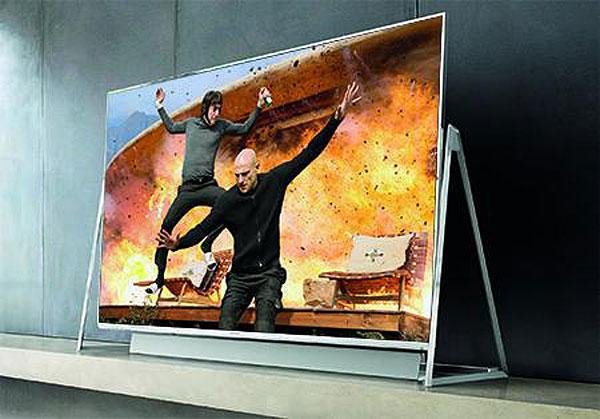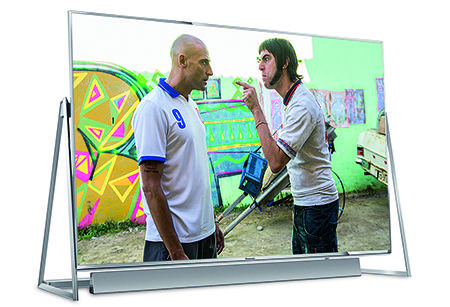Panasonic TX-58DX802 review


So unusual is the design that I guess it could prove divisive. Personally, though, I think it’s rather clever, particularly the way it makes such a large bit of AV hardware feel light and lithe rather than an overpowering presence in your movie room. The only niggle is that if you want to sit it on furniture rather than the floor, said furniture will have to be at least as wide as the full width of the TV plus its legs.
The 58DX802’s screen can be detached from its legs and hung on a wall if you’d prefer (using a provided bracket), though I don't envisage many of the TV's likely style-conscious buyers following this path.
Wall-hanging the screen also raises the practical question of where you put its soundbar speaker. Yes, that’s right: in another left-field move Panasonic hasn’t built any speakers into the 58DX802’s main bodywork, choosing instead to ship the TV with an external soundbar designed to sit between the easel legs. And this hopes to be no half-baked audio add-on either; tucked inside its reasonably compact form are two tweeters, four mid-range drivers and six woofers. This too can be wall-mounted, but needs a wired connection to the TV.
It might have been nice given the design if the 58DX802 had used an external connections box to minimise cable spaghetti, in the style of Samsung's SUHD displays. That's not the case, although the Panasonic does feature a decent cable management system to tidy up its trailing wires. As expected, there are four HDMI inputs, three USB ports and an Ethernet port. The latter can, of course, be ignored in favour of integrated Wi-Fi if you’d prefer.
The 58DX802’s smart features are provided through a TV-optimised version of the Firefox operating system. This continues to be one of the most attractive, easy to use and customisable operating systems around. My advice is, as always, to spend a few minutes optimising the home page for your needs when you first get the TV. Content apps are first-rate, with the 4K and HDR-enabled versions of both Netflix and Amazon on tap, plus the catch-up TV apps for all the ‘big four’ UK broadcasters delivered in the user-friendly Freeview Play wrapper.
Getting the edge on imageryThe 58DX802’s images are crafted via an edge LED lighting system with local dimming, and the 'Super Bright' panel is designed to deliver both enhanced brightness and a wider colour gamut than typical LCD screens.
It's a set made for HDR material then (of the HDR 10 variety), while Panasonic’s new Studio Master HCX video processing system (although not the '+' iteration found on the higher-end, direct-lit DX902 sets) is on hand to try and ensure that pictures look just as their creators intended.
When it comes to those in-demand badges, the 58DX802’s picture quality efforts bag it THX certification for standard dynamic range – THX doesn’t currently certify HDR. At the same time, though, the TV doesn’t have enough brightness and colour range to meet the specifications laid down by the UHD Alliance's Ultra HD Premium standard.
Given my Ultra HD Blu-ray copy of Eddie the Eagle, I found the 58DX802 delivers mostly lovely pictures. This disc features some of the most effective use – in its subtlety – of wide colour and HDR technology seen to date, and its relatively gentle but accurate approach suits Panasonic’s quest for accuracy. Whether it’s the warm, 1980s tones of Eddie’s home or the crisp, cool, glistening, sun- and snow-drenched slopes of his training camp, the 58DX802 makes it all look both exquisitely natural where colour tones are concerned and, when required, beautifully dynamic.
While the dynamic highlights deliver an HDR experience, they never look forced or over-dominant, and there’s only slight evidence of detail clipping in the brightest areas.
The bright skies above Eddie the Eagle’s ski slopes also reveal the strength of Panasonic’s colour engine, as every tiny tonal nuance is delivered with almost immaculate subtlety, meaning you hardly ever see any of the striping (or ‘posterisation’) noise found to some extent on numerous other HDR TVs this year.
Overall image clarity is good. The fine details of the Eddie the Eagle Ultra HD platter (itself an upscale of a 2K master) come across with gorgeous precision, drawing you into the feel-good drama. However, the pin-sharp feel ebbs away slightly during fast motion or rapid camera pans. There's a consistent trace of motion blur if you’re not using any of the TV’s motion processing systems. The good news here is that the lowest setting of Panasonic’s Intelligent Frame Creation system can tackle this blur reasonably effectively without making a hash of the picture.

Swapping the Ultra HD Blu-ray of Eddie the Eagle for the standard Full HD Blu-ray version, this designer screen continues to impress. Its pictures look pretty much immaculate when not being pushed hard by the extra luminance and colour demands of an HDR source, and the Studio Master HCX system does an accomplished job of upscaling HD pictures to 4K. Motion blur isn't given an unwanted boost. It's a set that leaves your BD collection in safe hands.
LED headacheWhile the Panasonic's pictures are exceptional for the vast majority of the time, they're not immune to backlight inconsistencies. This is a flaw that’s causing headaches for almost every HDR-capable LCD TV this year, with rival OLED sets highlighting the limitations of LED illumination.
The difficulties LCD TVs have with putting light only where it’s really needed on a screen – especially those lit by edge-mounted LEDs – mean that when a very bright object appears against a darkened backdrop on the 58DX802 you can see sometimes quite defined ‘blocks’ of light spillage around it.
Furthermore, if the bright elements in a predominantly dark frame take over enough of the display, the whole light tone of the image can shift quite distractingly.
There’s also more general greyness over dark scenes than there would ideally be. A counter to this is to run the 58DX802’s adaptive backlight feature on its highest level of strength, but this can then lead to the image losing some of its lustre, and suffering more regularly with backlight instability and flickering. In fact, it's an interesting comparison to the Philips PUS760; that direct-lit model has more backlighting panache.
Serious sonicsYet overall, the Panasonic 58DX802 deserves to have this review wrap up on a positive note. So let me stress that the times when its light control shortcomings are exposed are fairly rare (and barely a factor with non-HDR material). Also, the accompanying soundbar turns out to be a rather serious bit of audio kit. Its front-firing nature gives movie soundtracks a sense of immediacy and attack, and it has the finesse and musicality to handle the subtle spatial detailing in the Eddie The Eagle UHD BD and the bursts of late 1980s pop the film occasionally indulges. It's not a substitute for a separate speaker array, but it's a cut above the TV speaker norm.
And then there's the styling. Designer TVs certainly have a place in the market, and I'd suggest Panasonic's easel approach has more wow-factor than a curved TV. That it matches this with enjoyable visuals makes it even more of a success.
Specification
3D: Yes. Active 4K: Yes. 3,840 x 2,160 HDR: Yes. HDR 10 Tuner: Yes. Freeview HD (Freeview Play); HD satellite Connections: 4 x HDMI; 3 x USB; headphone output; Ethernet port; optical digital audio output; component video input; composite video input; CI slot Sound: 40W Brightness (claimed): N/A Contrast ratio (claimed): N/A Dimensions (off stand): 1,290(w) x 753(h) x 36(d)mm Weight (off stand): 22.5kg
Features: Built-in Wi-Fi; USB/DLNA multimedia playback; 4K Studio Master HCX processing engine; touchpad remote; VESA mount compatible; ambient sensor; Freestyle Design; Game Mode; Firefox TV smart system; Bluetooth
 |
Home Cinema Choice #351 is on sale now, featuring: Samsung S95D flagship OLED TV; Ascendo loudspeakers; Pioneer VSA-LX805 AV receiver; UST projector roundup; 2024’s summer movies; Conan 4K; and more
|

















































